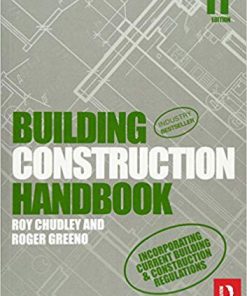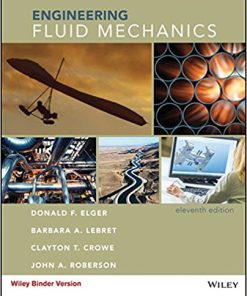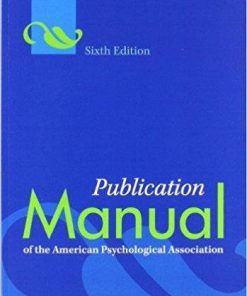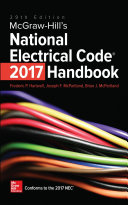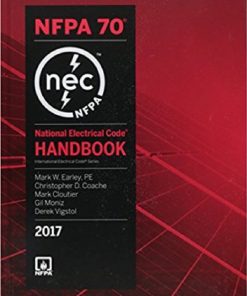(eBook PDF) National Association of Broadcasters Engineering Handbook 11th Edition
$50.00 Original price was: $50.00.$35.00Current price is: $35.00.
(eBook PDF) National Association of Broadcasters Engineering Handbook 11th Edition – Instant Download
(eBook PDF) National Association of Broadcasters Engineering Handbook 11th Edition – Digital Ebook – Instant Delivery Download

product details:
- ISBN-10 : 1138930512
- ISBN-13 : 978-1138930513
- Author: Garrison C. Cavell
The NAB Engineering Handbook is the definitive resource for broadcast engineers. It provides in-depth information about each aspect of the broadcast chain from audio and video contribution through an entire broadcast facility all the way to the antenna. New topics include Ultra High Definition Television, Internet Radio Interfacing and Streaming, ATSC 3.0, Digital Audio Compression Techniques, Digital Television Audio Loudness Management, and Video Format and Standards Conversion. Important updates have been made to incumbent topics such as AM, Shortwave, FM and Television Transmitting Systems, Studio Lighting, Cameras, and Principles of Acoustics.
The big-picture, comprehensive nature of the NAB Engineering Handbook will appeal to all broadcast engineers―everyone from broadcast chief engineers, who need expanded knowledge of all the specialized areas they encounter in the field, to technologists in specialized fields like IT and RF who are interested in learning about unfamiliar topics. Chapters are written to be accessible and easy to understand by all levels of engineers and technicians. A wide range of related topics that engineers and technical managers need to understand are covered, including broadcast documentation, FCC practices, technical standards, security, safety, disaster planning, facility planning, project management, and engineering management.
table of contents:
- Section 1: Fundamentals
- 1.1 The Electromagnetic Spectrum
- 1.2 The Fundamentals of Broadcast Coverage
- 1.3 Distance and Bearing Calculations
- Section 2: Broadcast Administration, Standards, and Technologies
- 2.1 Broadcast-Related Organizations and Information
- 2.2 Broadcast-Related Regulatory Considerations: Environmental, Aeronautical, Safety, Online
- 2.3 Frequency Coordination for Broadcast Auxiliary Services
- 2.4 Frequency Allocation for Broadcasting and the Broadcast Auxiliary Services
- 2.5 Analog and Digital Terrestrial Radio Standards
- 2.6 HF Shortwave Radio: Allocation, Design Methods, and Regulation
- 2.7 Worldwide Standards for Analog and Digital Television
- 2.8 Digital Audio Standards and Practices
- 2.9 Digital Video Standards and Practices
- 2.10 Broadcasting Emergency Information
- Section 3: Technical Management and Safety
- 3.1 Broadcast Engineering Management
- 3.2 Broadcast Engineering Documentation Management
- 3.3 System Integration and Project Management
- 3.4 Managing Workplace and Environmental Hazards
- 3.5 Human Exposure to Radio Frequency Energy
- 3.6 Broadcast Facility Security, Safety, Disaster Planning, and Recovery
- Section 4: Audio Production and Studio Technology
- 4.1 Principles of Acoustics and Noise Control for Broadcast Applications
- 4.2 Planning a Radio Studio or Audio Production Facility
- 4.3 Microphones for Broadcast Applications
- 4.4 In-Studio Audio Recording for Radio and TV
- 4.5 Telephone Network Interfacing
- 4.6 Radio Remote Broadcasts
- 4.7 Radio Station Automation, Networks, and Audio Storage
- 4.8 Digital Audio Compression Technologies
- Section 5: Video Production and TV Studio Systems
- 5.1 Principles of Light, Vision, and Photometry
- 5.2 Planning a Video Production and TV Studio Facility: Systems, Principles, Design, Architecture
- 5.3 Lighting for Television
- 5.4 Television Playout and Content Delivery
- 5.5 Television Camera Systems
- 5.6 Camera Supports
- 5.7 Closed Caption Services
- 5.8 Workflow and Professional Media Networks
- 5.9 Digital Asset Management
- 5.10 ATSC 1.0 Encoding, Transport, and PSIP Systems
- 5.11 Video Compression
- 5.12 Video Recording, Servers, and Storage
- 5.13 Format and Standards Conversion
- 5.14 Digital Television Audio Loudness Management
- 5.15 Weather Radar Systems
- 5.16 Television Graphics
- 5.17 ENG, SNG, and Remote Video Production
- 5.18 Television Audio: Analog and Digital Systems
- 5.19 Intercom and IFB Systems
- 5.20 Ultra-High-Definition Television
- Section 6: Facility Interconnection
- 6.1 Audio Contribution and Distribution Methods
- 6.2 Video Contribution and Distribution Methods
- 6.3 Satellite Uplinks and Downlinks for Contribution and Distribution
- 6.4 STL Systems for Radio and TV
- 6.5 Transmitter Remote Control and Monitoring Systems
- 6.6 Fiber Optic Transmission Systems
- Section 7: Radio Transmission
- 7.1 Planning Radio Transmitter Facilities
- 7.2 Transmission Audio Processing
- 7.3 Internet Radio Interfacing and Streaming
- 7.4 AM Radio Broadcasting
- 7.5 Medium Wave (AM) Transmitters
- 7.6 AM and FM IBOC Systems and Equipment
- 7.7 Worldwide Digital Radio Systems
- 7.8 Medium Wave AM Broadcast Antenna Systems
- 7.9 Antenna Coupling and Phasing Systems
- 7.10 AM Diplexing, Combining, and Filter System Design
- 7.11 Synchronous AM Broadcasting
- 7.12 AM Antenna System Maintenance
- 7.13 Antenna System Moment Method Modeling
- 7.14 FM Radio Broadcasting
- 7.15 VHF (FM) Radio Transmitters
- 7.16 Radio Data System
- 7.17 FM Broadcast Antennas
- 7.18 FM Combining and Filter System Design
- 7.19 FM and AM Translators and Boosters
- 7.20 HF Shortwave Radio
- 7.21 Hybrid Radio and the RadioDNS Open Standards
- Section 8: Television Transmission
- 8.1 Planning a Television Transmitter Facility
- 8.2 Analog Television Transmitters
- 8.3 Digital Television Transmitters
- 8.4 Next-Generation DTV Systems
- 8.5 Single-Frequency Networks for DTV Systems
- 8.6 Single-Frequency Networks (SFNs) for Television—Digital On-Channel Repeaters, Distributed Transmitters, and Distributed Translators
- 8.7 Television Antenna Systems
- 8.8 Television Filters, Combiners, and RF Components
- 8.9 Broadcast Television Co-Location Site Management
- Section 9: Broadcast Towers and Transmission Lines
- 9.1 Tower Design, Erection, and Maintenance
- 9.2 Lightning Protection for Towers
- 9.3 Tower Lighting and Monitoring
- 9.4 Transmission Lines for AM, FM, HF, and TV Stations and Associated Systems
- Section 10: Signal Measurement and Analysis
- 10.1 Audio Signal Analysis
- 10.2 AM Radio Performance Measurements
- 10.3 AM Radio Antenna System and Field Strength Measurements
- 10.4 FM Antenna Performance Measurements
- 10.5 FM Radio Field Strength Measurements
- 10.6 Digital Television Proof of Performance Measurements
- 10.7 TV Transmission Line and Antenna System Measurements
- 10.8 VHF and UHF Television Antenna Test Range Measurements
- 10.9 VHF and UHF Television Field Strength Measurements
- Section 11: Ancillary Broadcast Systems
- 11.1 Electrical Power Systems, Specification, Conditioning, Fault Protection
- 11.2 Facility Grounding Practice and Lightning Protection
- 11.3 Media Archives
- Index
people also search:
the national association of broadcasters
nd broadcasters association
what does the national association of broadcasters do
what is the national communication association
radio broadcasting association
national association of broadcasters television code
You may also like…
Housekeeping & Leisure - Interior Design & Decoration
NFPA 70: National Electrical Code (NEC) Handbook 2017 1st Edition – eBook PDF




